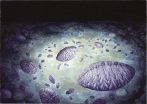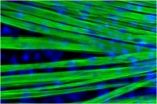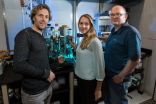(Press-News.org) Various sight recovery therapies are being developed by companies around the world, offering new hope for people who are blind. But little is known about what the world will look like to patients who undergo those procedures.
A new University of Washington study seeks to answer that question and offers visual simulations of what someone with restored vision might see. The study concludes that while important advancements have been made in the field, the vision provided by sight recovery technologies may be very different from what scientists and patients had previously assumed.
In a paper published Aug. 3 in the journal Philosophical Transactions B, UW researchers used simulations to create short videos that mimic what vision would be like after two different types of sight recovery therapies. Lead author Ione Fine, a UW associate professor of psychology, said the simulations are unprecedented.
"This is the first visual simulation of restored sight in any realistic form," she said. "Now we can actually say, 'This is what the world might look like if you had a retinal implant.'"
Fine said the paper aims to provide information about the quality of vision people can expect if they undergo sight restoration surgery, an invasive and costly procedure.
"This is a really difficult decision to make," she said. "These devices involve long surgeries, and they don't restore anything close to normal vision. The more information patients have, the better."
More than 20 million Americans aged 18 and older have experienced vision loss, according to the American Foundation for the Blind, and rates of vision loss are expected to double by 2030 as the nation's population ages.
For many of these patients, vision loss occurs after light enters the eye and lands on the retina, a thin layer at the back of the eye that contains millions of nerve cells.
Among those are cells called rods and cones, which convert light into electrical impulses that are transmitted to vision centers in the brain. Loss of rods and cones is the primary cause of vision loss in diseases such as macular degeneration or retinitis pigmentosa.
But those diseases leave most remaining neurons within the retina relatively intact, and various technologies under development aim to restore vision by targeting the surviving cells.
This is a pivotal time for the industry, Fine said, with one company that has a device on the market and several others set to enter the market in the next five to 10 years.
Two of the most promising devices, she said, are electric prostheses, which enable vision by stimulating surviving cells with an array of electrodes placed on the retina, and optogenetics, which insert proteins into the surviving retinal cells to make them light-sensitive.
But the devices have a major shortcoming, co-author Geoffrey Boynton said, since stimulating the surviving cells in a retina is unlikely to produce vision that is close to normal.
"The retina contains a vast diversity of cells that carry distinct visual information and respond differently to visual input," said Boynton, a UW psychology professor.
"Electrically stimulating the retina excites all of these cells at the same time, which is very different from how these cells respond to real visual input."
There are similar issues with optogenetics, Boynton said. "The optogenetic proteins that are currently available produce sluggish responses over time, and they are limited in the number of different cell types that they can separately target," he said.
These limitations in both technologies mean that patients may see fuzzy, comet-like shapes or blurred outlines, or they may experience temporary visual disappearances if an object moves too fast.
Previous simulations of restored vision have used a "scoreboard model," a grid of dots similar to the scoreboard at a football game, in which each electrode produces a visible dot in space. Together, that collection of dots is intended to demonstrate what someone with restored vision will see.
Fine said the new simulations show that the scoreboard model, which is sometimes used to test devices, doesn't provide a good representation of the quality of vision sight restoration technologies are likely to produce.
More realistic models are needed, she said, to give patients, clinicians and researchers a better idea of how those technologies will work in the real world.
Fine said better simulations can provide valuable information about how implants need to be improved to produce more natural vision.
"As these devices start being implanted in people, we can compare different types of devices and the different perceptual outcomes of each," she said. "The path to fully restored eyesight is an elusive target. We need to start developing more sophisticated models of what people actually see.
"Until we do that, we're just shooting in the dark in trying to improve these implants."
INFORMATION:
For more information, contact Fine at ionefine@uw.edu or 206-685-6157.
Recent research has shown that the more time employees spend in their chairs, the more likely they are to develop serious health problems such as diabetes, heart disease, and obesity. The July special issue of Ergonomics in Design examines the health and safety effects of the sedentary workplace, the pros and cons of alternatives to sitting at work (for example, sit-stand and treadmill workstations, ball chairs), and proposed workplace design solutions. The full text of the issue, guest edited by Jack Dennerlein, is now available online and may be found at http://erg.sagepub.com/content/current.
"With ...
Scientists from the University of Leeds have uncovered further evidence that the protective buffers at the ends of chromosomes - known as telomeres - are fundamental to the understanding of the deadliest form of skin cancer, melanoma.
A team of international researchers, co-led by Dr Mark Iles from the University's School of Medicine and St James's University Hospital in Leeds, has uncovered five new common genetic risk factors for melanoma. They have also confirmed two others previously suspected to be risk factors.
Dr Iles said: "This research establishes further ...
Researchers led by the University of Cambridge have found the earliest example of reproduction in a complex organism. Their new study has found that some organisms known as rangeomorphs, which lived 565 million years ago, reproduced by taking a joint approach: they first sent out an 'advance party' to settle in a new area, followed by rapid colonisation of the new neighbourhood. The results, reported today in the journal Nature, could aid in revealing the origins of our modern marine environment.
Using statistical techniques to assess the distribution of populations ...
High-dose vitamin D supplementation in postmenopausal women was not associated with beneficial effects on bone mineral density, muscle function, muscle mass or falls, according to the results of a randomized clinical trial published online by JAMA Internal Medicine.
Low levels of vitamin D contribute to osteoporosis because of decreased total fractional calcium absorption (TFCA) and nearly half of postmenopausal women sustain an osteoporotic fracture. However, experts disagree on the optimal vitamin D level for skeletal health. Some experts contend that optimal serum ...
A recently discovered family of small RNA molecules, some of which have been implicated in cancer progression, has just gotten much larger thanks to a new RNA sequencing technique developed by researchers at UC Santa Cruz.
The technique, described in a paper published August 3 in Nature Methods, provides sensitive detection of small RNAs that are chemically modified (methylated) after being transcribed from the genome. The researchers used the technique to reveal an abundance of modified fragments derived from transfer RNA molecules in both yeast cells and human cells.
"Transfer ...
Skeletal muscle is one of the most abundant tissue types in the human body, but has proven difficult to produce in large quantities in the lab. Unlike other cell types, such as heart cells, neurons and cells found in the gut, previous attempts to efficiently and accurately derive muscle cells from pre-cursor cells or culture have not been fruitful. In a new study published this week in Nature Biotechnology, investigators from Brigham and Women's Hospital (BWH) report that by identifying and mimicking important developmental cues, they have been able to drive cells to grow ...
LA JOLLA--T cells are the guardians of our bodies: they constantly search for harmful invaders and diseased cells, ready to swarm and kill off any threats. A better understanding of these watchful sentries could allow scientists to boost the immune response against evasive dangers (e.g., cancer or infections), or to silence it when it mistakenly attacks the body itself (e.g., autoimmune disorders or allergies).
Now, scientists at the Salk Institute have discovered that T cell triggering relies on a dynamic protein network at the cell surface, as reported in August 3, ...
New brain research has mapped a key trouble spot likely to contribute to intellectual disability in Down syndrome. In a paper published in Nature Neuroscience [3 Aug], scientists from the University of Bristol and UCL suggest the findings could be used to inform future therapies which normalise the function of disrupted brain networks in the condition.
Down syndrome is the most common genetic cause of intellectual disability, and is triggered by an extra copy of chromosome 21. These findings shed new light on precisely which part of the brain's vast neural network contribute ...
Greenhouse-gas emissions from human activities do not only cause rapid warming of the seas, but also ocean acidification at an unprecedented rate. Artificial carbon dioxide removal (CDR) from the atmosphere has been proposed to reduce both risks to marine life. A new study based on computer calculations now shows that this strategy would not work if applied too late. CDR cannot compensate for soaring business-as-usual emissions throughout the century and beyond, even if the atmospheric carbon dioxide (CO2) concentration would be restored to pre-industrial levels at some ...
NEW YORK, NY (August 3, 2015) - Scientists at The New York Stem Cell Foundation (NYSCF) Research Institute successfully designed a revolutionary, high-throughput, robotic platform that automates and standardizes the process of transforming patient samples into stem cells. This unique platform, the NYSCF Global Stem Cell ArrayTM, for the first time gives researchers the scale to look at diverse populations to better understand the underlying causes of disease and create new individually tailored treatments, enabling precision medicine in patient care.
A paper published ...


